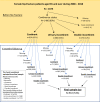Factors associated with urinary and double incontinence in a geriatric post-hip fracture assessment in older women
- PMID: 34984652
- PMCID: PMC9151507
- DOI: 10.1007/s40520-021-02046-z
Factors associated with urinary and double incontinence in a geriatric post-hip fracture assessment in older women
Abstract
Background: Incontinence and hip fractures are common in older people, especially women, and associated with multiple adverse effects. Incontinence is a risk factor for falls.
Aims: We aimed to investigate the prevalence of urinary (UI) and double incontinence (DI, concurrent UI and faecal incontinence), and to identify factors associated with UI and DI 6 months post-fracture.
Methods: A prospective real-life cohort study was conducted consisting of 910 women aged ≥ 65 who were treated for their first hip fracture in Seinäjoki Central Hospital, Finland, between May 2008 and April 2018. Continence status was elicited at baseline and 6 months postoperatively at our geriatric outpatient clinic where all participants underwent a multidisciplinary comprehensive geriatric assessment (CGA) consisting of an evaluation of cognition, nutrition, mood, mobility, and functional ability.
Results: At baseline, 47% of the patients were continent, 45% had UI and 8% had DI, and at follow up, 38%, 52%, and 11%, respectively. The mean age of the patients was 82.7 ± 6.8. Both UI and DI were associated with functional disability and other factors related to frailty. The associations were particularly prominent for patients with DI who also had the worst performance in the domains of CGA. We identified several modifiable risk factors: depressive mood (odds ratio [OR] 1.81; 95% confidence interval [CI] 1.16-2.84) and constipation (OR 1.48, 95% CI 1.02-2.13) associated with UI and, late removal of urinary catheter (OR 2.33, 95% CI 1.31-4.14), impaired mobility (OR 2.08, 95% CI 1.05-4.15), and poor nutrition (OR 2.31, 95% CI 1.11-4.79) associated with DI.
Conclusions: This study demonstrates a high prevalence of UI and DI in older women with hip fracture and modifiable risk factors, which should be targeted in orthogeriatric management and secondary falls prevention. Patients with DI were found to be an especially vulnerable group.
Keywords: Double incontinence; Frailty; Hip fracture; Urinary incontinence.
© 2022. The Author(s).
Conflict of interest statement
The authors declare that they have no conflicts of interest.
Figures
Comment in
-
Geriatrics.J Urol. 2023 May;209(5):1006-1008. doi: 10.1097/JU.0000000000003369. Epub 2023 Feb 22. J Urol. 2023. PMID: 37026643 No abstract available.
References
MeSH terms
Grants and funding
LinkOut - more resources
Full Text Sources
Medical
Research Materials
Miscellaneous


